Where’s the best place to look for down to earth information on nanotechnology safety? Surprisingly, given how much time I spend speaking and writing about the subject, I don’t think I have ever sat down and compiled such a list. But while preparing for this year’s annual meeting of the Nanotechnology Informal Science Education Network (NISE Net) (surely the coolest nanotech meeting around by the way!) it struck me that such a list might actually be useful.
So here’s my first cut at some places you might want to look if you are interested in nanotech safety.
It’s by no means exhaustive, and it was compiled primarily to support my talk at the NISE Net annual meeting this week. But it might be of some use – especially if you are interested in the subject, but don’t know where to start.
In putting the list together, I’ve tried to focus on papers and websites that are informative and trustworthy (in my opinion), that you don’t need a PhD in nanotoxicology to get something out of, and that are freely available. In each case, I have tried to provide some idea of what each resource covers, and who might find it useful.
There are bags more good resources out there – this is just a start. But hopefully, it’s a useful one.
Nano & Me
What is it? A website targeted at providing readers with clear and accessible information on nanotechnology. Created by the UK-based Responsible Nano Forum and the Together Agency, and supported by the UK Department for Business, Innovation and Skills (BIS), it covers everything from what nanotech is, to where it’s being used. The website’s coverage of safety issues is simple, clear and balanced.
Who should use it? Anyone who wants to know more about nanotechnology, but especially newbie’s to the subject. No science required.
What I like about it: A slick website that puts the information you are looking for at your fingertips, without being condescending or confusing. Highly recommended.
Link: http://www.nanoandme.org
Nanoscience and nanotechnologies: Opportunities and uncertainties
What is it? An influential 2004 review of the opportunities and challenges of nanotechnology, from the UK Royal Society and Royal Academy of Engineering. Chapter 5 provides an excellent overview of the potential risks presented by some products of nanotechnology, and is still relevant five years on.
Who should read it? The report was written for the UK government, but you don’t need a degree in science to understand it. A slightly meatier read than the Nano & Me website.
What I like about it: Informed, authoritative, relevant and readable.
Link: http://www.nanotec.org.uk/finalReport.htm
Risk Assessment of Products of Nanotechnology (SCENIHR)
What is it? A detailed technical report on the current state of the science on nanotechnology safety from SCENIHR – the European Directorate General for Health and Consumers Scientific Committee on Emerging and Newly Identified Health Risks.
Who should read it? This is a technical document, and will probably be more soporific than stimulating to anyone not steeped in nanotechnology safety research and policy. But if you can get over this barrier, it contains a wealth of information. There is also a lay version of the report available online though, that is well worth checking out.
What I like about it: Its depth and relevance.
Link: http://ec.europa.eu/health/ph_risk/committees/04_scenihr/docs/scenihr_o_023.pdf [PDF, 500 KB]
Nanotoxicology: An emerging discipline evolving from studies of ultrafine particles.
What is it? A review paper on “nanotoxicology” written in 2005 by the father, daughter and son team of Günter, Eva and Jan Oberdörster.
Who should read it? Researchers, regulators, decision makers and anyone else interested in nanoparticle toxicity. This is an academic review paper, so you probably wouldn’t want to read it if you only had a passing interest in nanotechnology safety. But for anyone who isn’t scared of a bit of science, it provides an excellent review of the field that is still relevant four years on.
What I like about it: Günter Oberdörster is one of the foremost authorities on nanoparticle toxicity, and this paper expertly sets out the important questions surrounding nanoparticle toxicology. Highly recommended reading.
Link: http://www.ehponline.org/docs/2005/7339/abstract.html
Nanoparticles, human health hazard and regulation
What is it? A recent review paper by Anthony Seaton, Lang Tran, Rob Aitken and Ken Donaldson that provides a unique and highly informative overview of nanoparticle safety from the perspective of the workplace.
Who should read it? Anyone trying to make sense of the possible risks presented by engineered nanoparticles, and how to avoid them.
What I like about it: Well-presented arguments that frame engineered/manufactured nanoparticle risks in the context of what is already known, and what still needs to be known.
Link: http://rsif.royalsocietypublishing.org/content/early/2009/08/31/rsif.2009.0252.focus.full
Approaches to Safe Nanotechnology: An information exchange with NIOSH
What is it? A compendium of information on nanotechnology safety in the workplace, from the US National Institute for Occupational Safety and Health.
Who should read it? Anyone responsible workplace safety. The report is also a mine of information for readers of all backgrounds who are interested in the safety of engineered nanomaterials.
What I like about it: A comprehensive and periodically updated evaluation of the state of the science on nanomaterial safety, from one of the world’s foremost workplace safety research organizations.
Link: http://www.cdc.gov/niosh/topics/nanotech/safenano/
National Nanotechnology Initiative website
What is it? The official website of the US National Nanotechnology Initiative (NNI). The website includes a section on environmental, safety and health aspects of nanotechnology.
Who should read it? Anyone interested in the US government’s take on nanotechnology safety.
What I like about it: It’s a window into what the US government – one of the leading funders of nanotechnology research and development – are doing in this area.
Link: http://www.nano.gov/html/society/EHS.html
International Council On Nanotechnology website
What is it? A multi-stakeholder organization set up by the Center for Biological and Environmental Nanotechnology (CBEN) at Rice University. For info. on nanotechnology safety, check out the backgrounders, the news feed (also on Twitter) and the ICON blog.
Who should use it? The ICON backgrounders, blog and news feed are relevant to anyone interested in the latest developments in nanotech safety.
What I like about it: Comprehensive news on nanotechnology safety, and background papers that explain complex science in a simple way.
Link: http://icon.rice.edu/
SAFENANO website
What is it? An information resource on nanotechnology safety, from the UK-based Institute for Occupational Medicine. A great source of news, analysis and opinions.
Who should use it? Anyone interested in the latest on nanotechnology safety, with a focus on the workplace.
What I like about it: Down to earth information. I also contribute to the SAFENANO blog though, so I might be biased!
Link: http://www.safenano.org/
2020 Science website
What is it? OK so this is a little self-serving, but I write so much about nanotechnology safety that I thought I should include 2020 Science here. For a list of nanotech safety-related blogs, check these out, or start off with Ten things everyone should know about nanotechnology safety.
Who should use it? Anyone who wants to find out more about issues around nanotechnology safety.
What I like about it: Mmm, I don’t think I’m the best qualified person to answer that.
Link: https://2020science.org
In restricting myself to ten resources here, I’m sure I have failed to mention many that others would have included. So if you have a publicly accessible website, paper or other resource on nanotechnology safety you think people would find useful, please do mention it in the comments below.
Update 09/15/09: Linked screenshots to respective websites

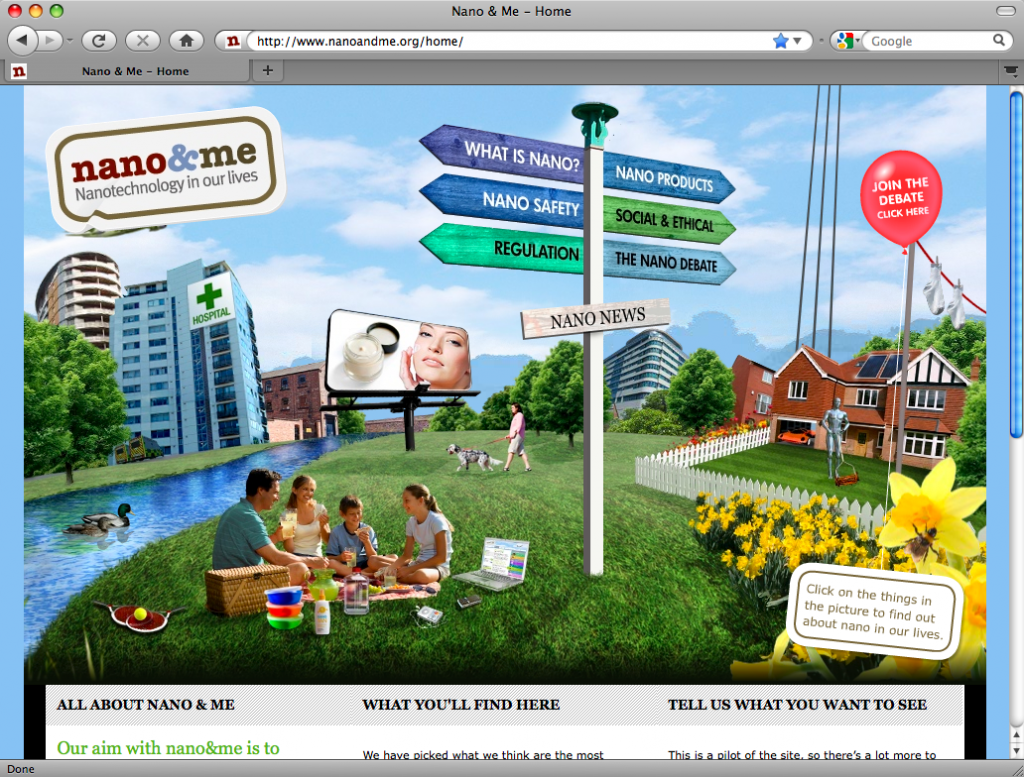
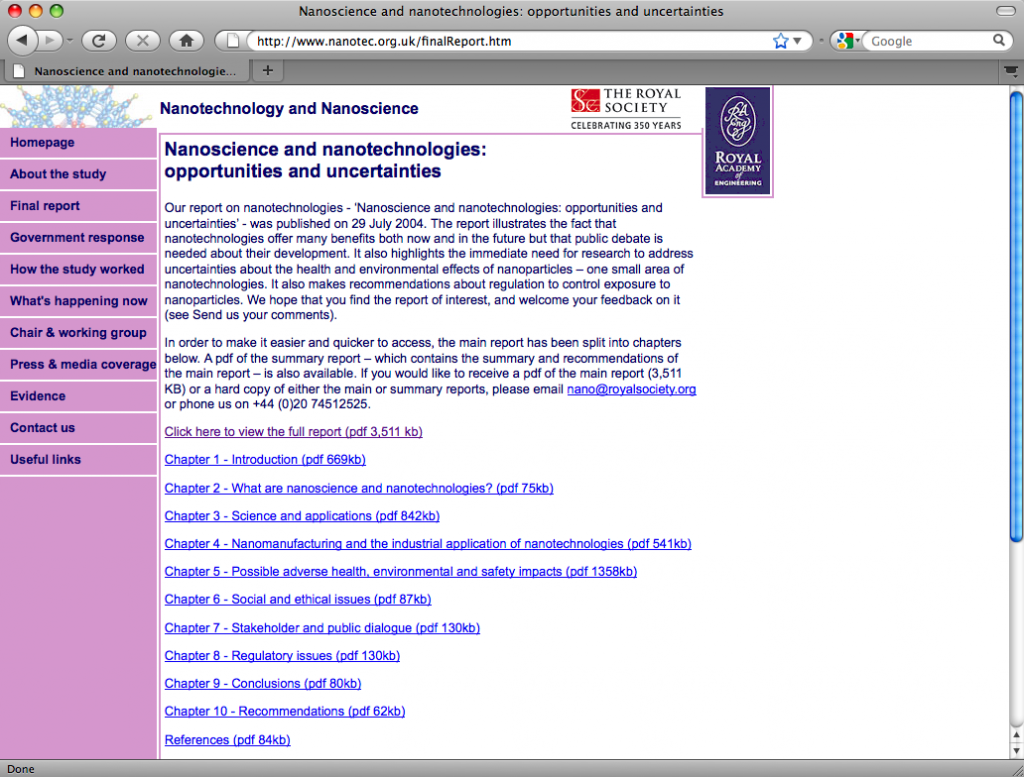
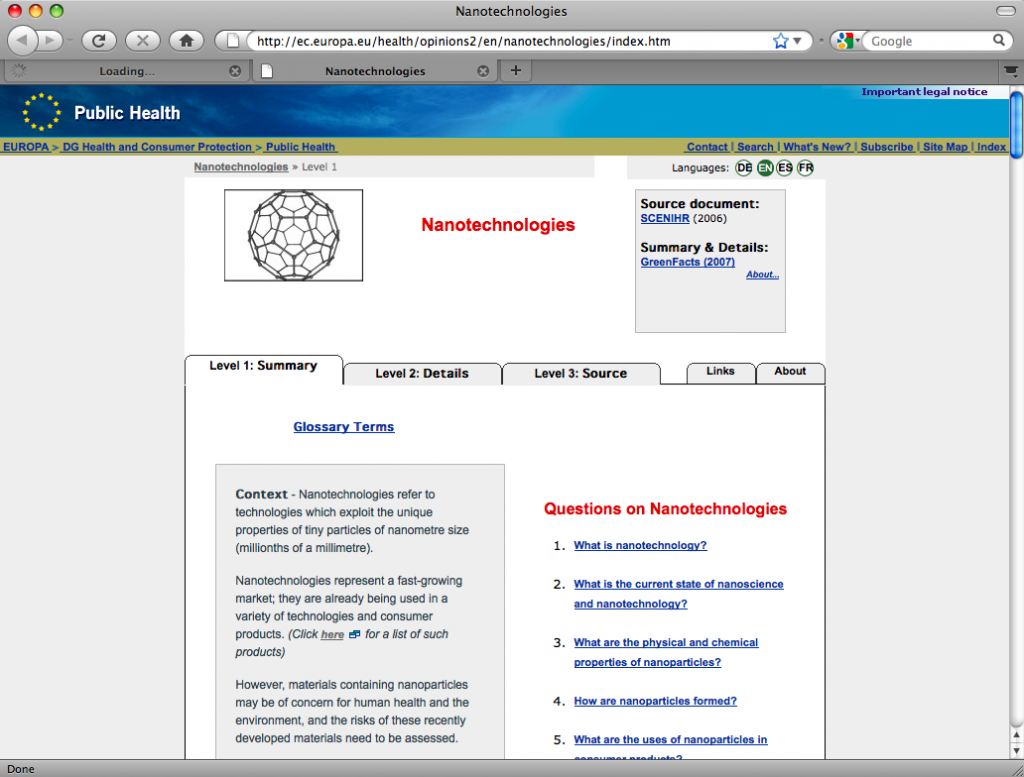

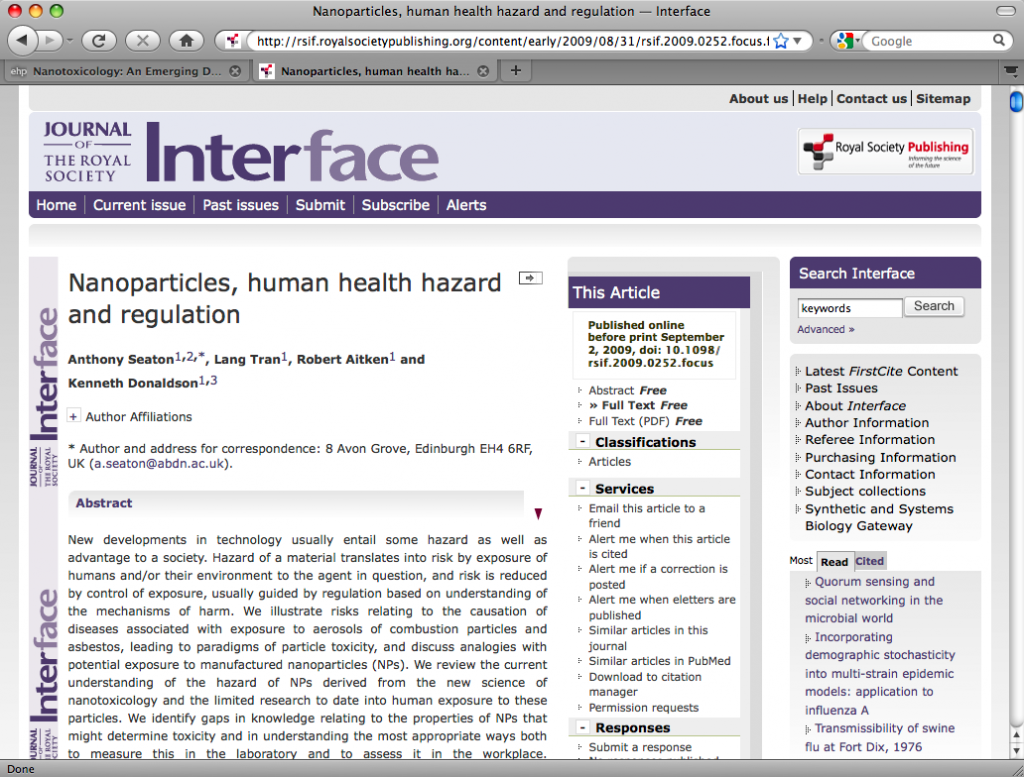
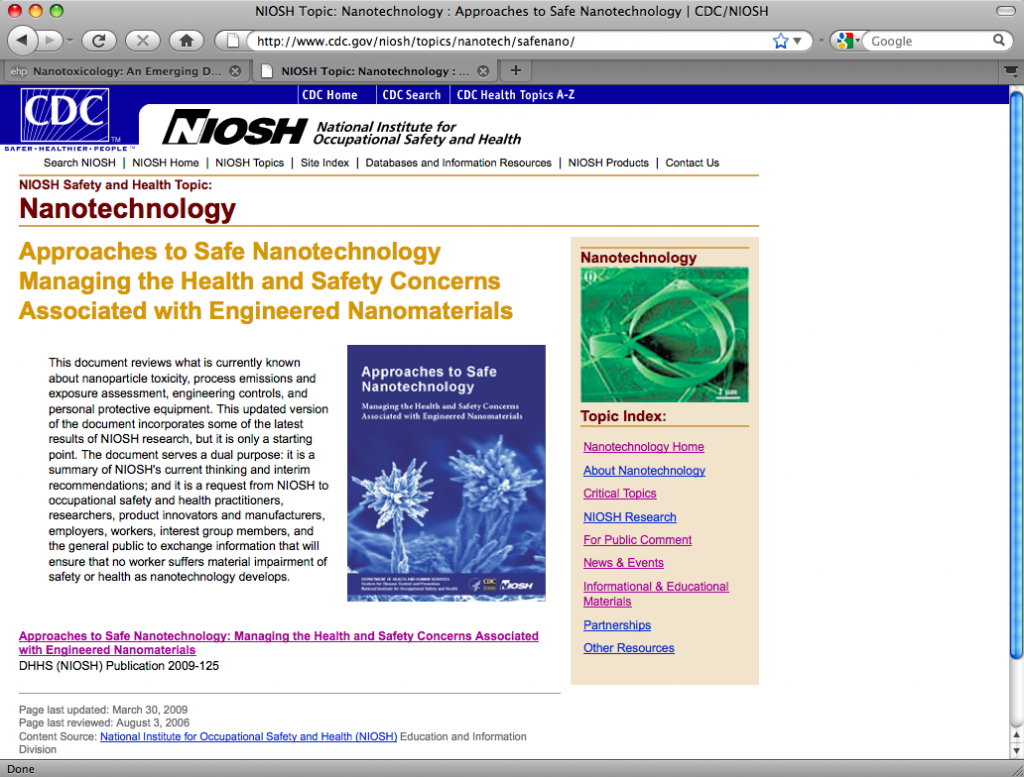
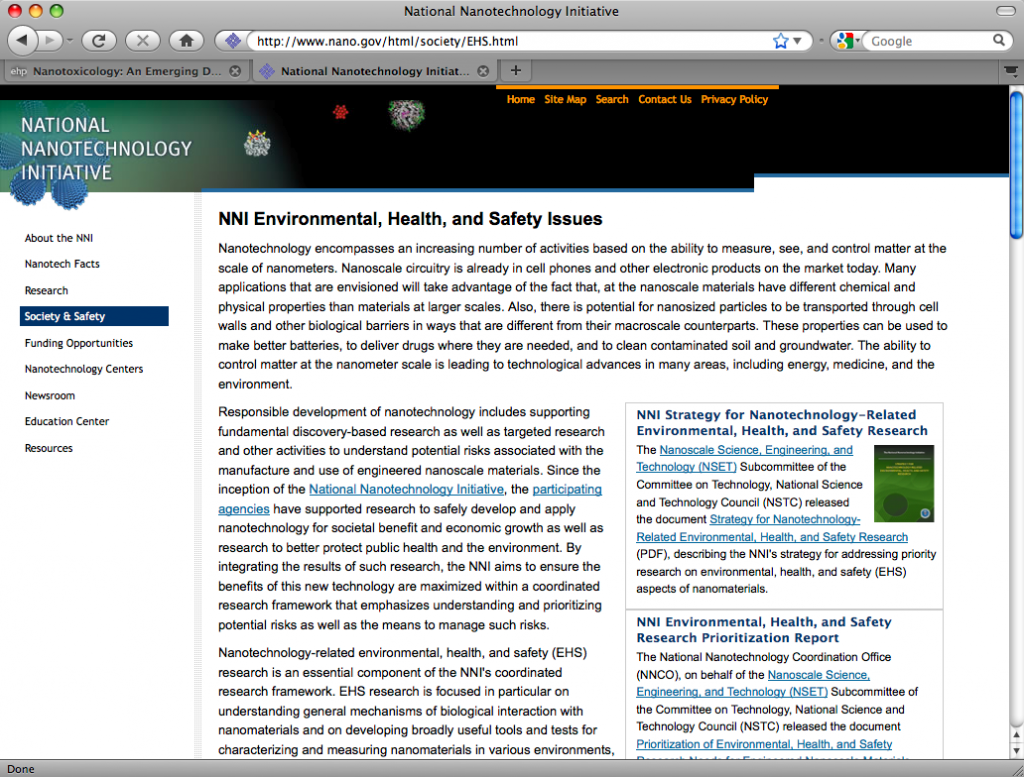

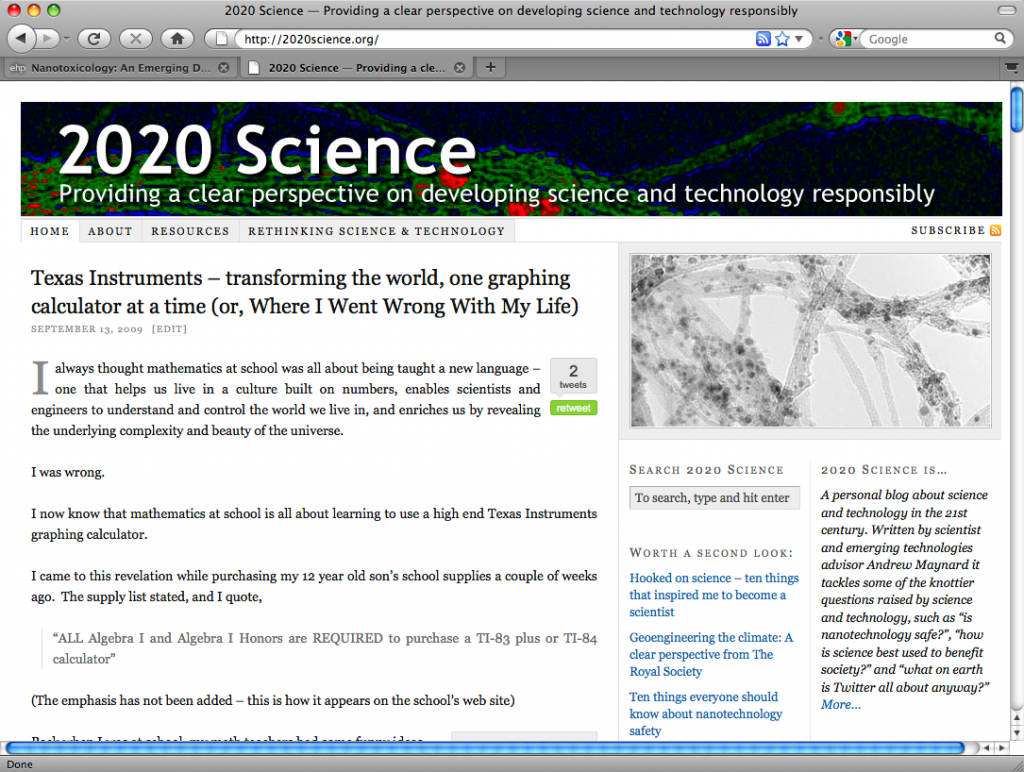
Wonderful items from you, man. I’ve take note your stuff previous to and you are just extremely fantastic. I actually like what you’ve bought here,
really like what you are saying and the way through which you say it.
You’re making it enjoyable and you continue to care for to stay it wise. I can’t
wait to read far more from you. This is really a tremendous web site.